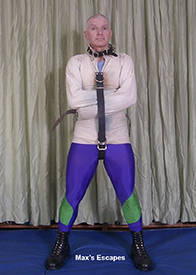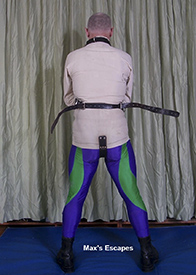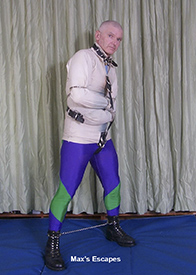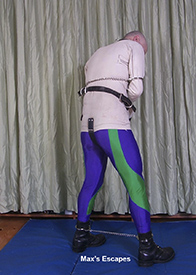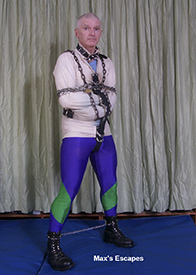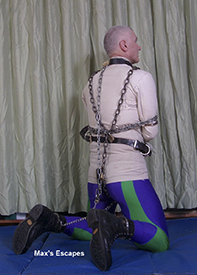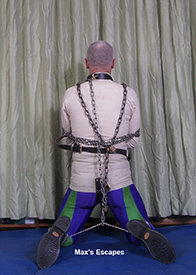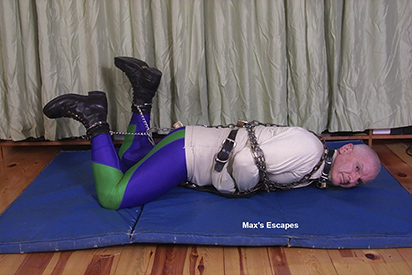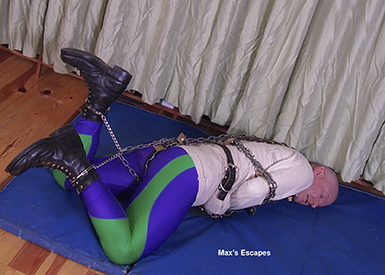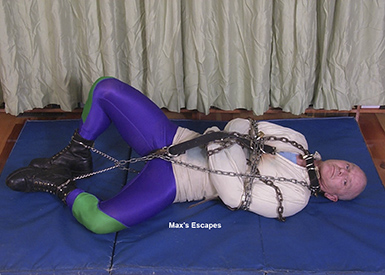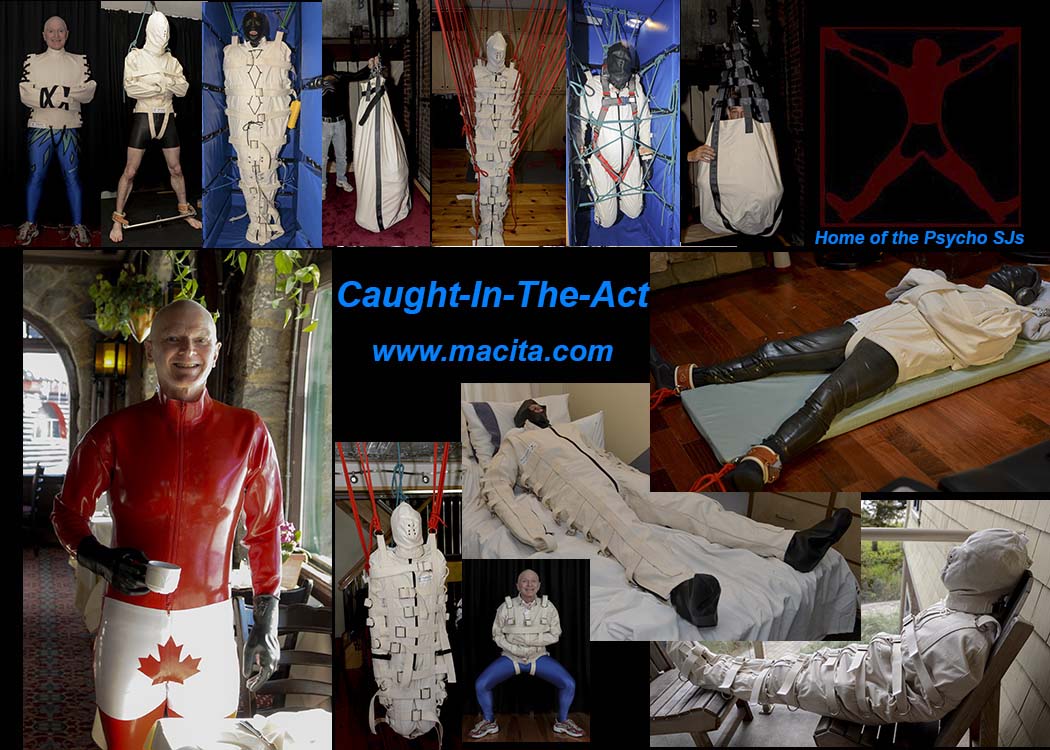
Max Cita's First Straitjacket Escape
Max Cita was considered an amateur, hokey escape artist. Simply, he would challenge people to tie him up with rope and see if he could escape. That all started at a very early age - the cowboys and Indians games with his friends started when he was only 8. It continues to the present time. Max was fascinated with the rope and escape challenge, not just to be able to empower himself to escape no matter who, or how he was tied up, but the process of being restrained and the escape itself was an empowering stimulant. He liked that - the hours of escape attempts - the joy of winning, the frustration of losing, all in good fun. The original Max Straitjacket is now in a permanent retirement home at SJFLoats here http://members.tripod.com/sjfloats/max.html. (We change the name to: "Max Cita Straitjacket" to avoid misconstruing Max's original 'Max Straitjacket' with others now using that name for theirs.) In Max's past, he had a chance to buy a straitjacket from a junk store in 1965. He fell in love with it, only $15.00, but there was no way he could have it at home with parents who could never understand him. He fantasized about the straitjacket for years. He went back to the store two years later and it was gone - of course. He searched for another in every surplus store he could find. He had not heard of Posey, Best or Humane Restraint until 20 years later. In 1977 Max decided to make his own Straitjacket to advance the difficulty of the escape challenge thrill. He had tried the commercial ones but not in the budget to actually buy. Max wanted to mimic the Houdini escapes he read about over and over. The imagery of restraint and confinement of Houdini in an sj, and the ease in which Houdini seemed to escape was magic to Max. He really wanted to taste the impossible. As best he could he designed a simple sj. His home life prevented him from openly sharing his interest. There was no understanding or acceptance, so he had to go the solo route or with distant friends who understood and shared the secret fascination. The straitjacket use would be limited for the next few years. The Max Cita Straitjacket shirt material was a 14 once cotton, jean material but unbleached cotton. D-rings and buckles were purchased at local retail suppliers. Sewing was by hand or using a lightweight Singer sewing machine. The Straitjacket is a pull on shirt, with a neck and waist opening only. The sleeve ends were sewn shut with buckles at each end. Leather was used to reinforce the sewing as needed. The crotch strap was a long thick leather belt sewn at the back and buckled at the waist in the front. The leather crotch belt was long enough to buckle not only at the waist - front, but was long enough to form a sleeve loop in front which had a second buckle at the collar. This configuration was somewhat easy to get into and out-of as a solo exercise. D-rings on a nylon webbing sewn into the sj collar could hold a removable leather collar that when done up, closed the neck opening of the sj. The sj offered a lot of relaxing solo challenges for Max. He found the ease in getting in and out was no longer a great challenge by 1984. Friends helped Max experiment with the sj, adding rope and using various positions to increase the challenge. Max also started to wear thick rubber gloves inside the sleeves to limit finger dexterity and movement. Some success in escape and many less successful. It was all in the fun. Max used the Max Cita Straitjacket for some promotions in 1989. Discovering that people actually appreciated escape performances he added it to the list of little escape challenges he would do at private fetish parties. The sj was worn over latex, or lycra, it was soaked in sweat, badly stained, to take on a well-used look. Rips and tears were repaired, then used again and again. The escape challenges using the sj were of every variety possible. There were hog ties, suspension, rope mummification, arms restrained behind, down the sides, in front, behind the head. The most difficult escapes seemed to be in the sj arms crossed, then Max was tied with rope to a ladder, then the ladder placed on the floor with Max on top. It used to take hours, if not all night. Handcuffs and leg irons put on over the straitjacket were used too, but without a key, he could not escape. By 1985, Max was making leather restraints and started on bodybags. The leather restraints- the collar and cuff escapes, took over from the tired well used older sj escapes. Max invested in a Posey SJ in the early 90's and spent considerable time figuring out how to escape, the much sturdier and more complex sj. Professional shows were being booked, a better act was needed from 1993 on. The Posey became the performance sj, and still is. (The Caught-In-The-Act Psycho Sj is now being challenged for escape acts, no takers to date.) The demand for more realistic sj escapes has put the old tired original Max Straitjacket into retirement. The Max Cita Straitjacket has hung in the prop closet gathering dust taking up much needed space. It needed to be retired. A good home was found at SJFloats. Today Max Cita produces custom and stock straitjackets for escape artists, other professionals, and fetish crowds. The Caught-In-The-Act - Psycho remains the ultimate escape challenge. Max can escape the Psycho under certain conditions, first and foremost the Psycho must be sized correctly and done up as it was intended as a no release, no escape method. In other words, no tricks in doing it up too loose, or leaving buckles undone. Enough said, the challenge will be presented on Max's web page at some point in the future. Thanks to SJFloats (http://members.tripod.com/sjfloats/max.html) for giving this well loved sj a new home. |
The
hardest to escape, if at all: a set of leg irons locking
each biceps with the chain across the back. Reaching to unlock
the cuff is nearly impossible from the front. |
Adding chain and locking it instead is actually the easiest to escape . Note the subtle change in stance. That gives a little slack in the chain to start the escape. Chain across the back an through the crotch makes it look tougher than it really is. |
The SJ now is on display at sj floats museum in New York |
| As I look back on the late 80's early 90's performances I see I had a lot more ability than I do now. Arthritis and aging takes its toll. I still like to do escape challenges as often as I can. Neve too old to stop trying.r |


